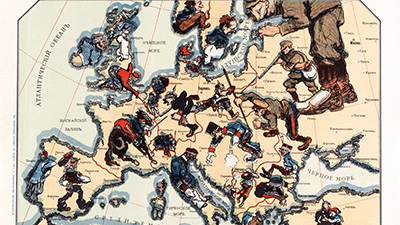Global Conflict
Teacher Resources
Driving Question: What were the causes of global conflict from 1900 to the present?
The first half of the twentieth century was unlike anything that came before. Nations around the world became embroiled in conflict. Two world wars, one from 1914 to 1918, and the other from 1939 to 1945, unleashed unprecedented amounts of devastation and wrought havoc upon nations, their people, and their economies. In this unit, you will explore how this era of conflict unraveled, as well as the grave consequences of that conflict.
Learning Objectives
- Explain how historical, internal, and global factors led to changes in various states after 1900 CE.
- Understand how different factors, both internal and external, led to global shifts in power after 1900.
Vocab Terms:
- antisemitism
- authoritarianism
- communism
- fascism
- ideology
- militarism
- total war
Opener: Global Conflict
To teach this lesson step, refer to page 3 of the Lesson 7.0 Teaching Guide.
You’ll learn more about the causes of World War I in this lesson. First, analyze a cartoon to make your own hypothesis.
Unit 7 Overview
To teach this lesson step, refer to page 3 of the Lesson 7.0 Teaching Guide.
Want to make sure students are engaging academically with videos? Take a look at OER Project Video Guide for some great ideas on how to do this!
The first half of the twentieth century saw two devastating world wars that involved nations, colonies, and economies in total conflict. This video explores how these wars began, the attempts to prevent them, and how the failures after World War I led to an even more destructive World War II.
-
Guiding Questions
-
Before you watch
Preview the questions below, and then review the transcript.
While you watch
Look for answers to these questions:
- What does total war mean?
- Who was Jeanette Rankin?
- What was “the war to end all wars” and how quickly was this proven wrong?
- How did industrial imperialism lead to global conflict?
- What made the world wars “total wars”?
- How did nations attempt to prevent another global conflict, both during the interwar period after the First World War and after the Second World War?
- Why did Jeanette Rankin vote against US entry into the Second World War?
After you watch
Respond to the following questions:
- At the end of this video, Rachel Hansen poses a series of questions regarding war. Do you think that this era of global conflict and the creation of the United Nations have deterred future conflicts?
- Do you agree with Jeanette Rankin’s votes against entry into both world wars? Explain your reasoning.
Key Ideas
Unit 7 Introduction: Global Conflict, 1900–Present
To teach this lesson step, refer to page 4 of the Lesson 7.0 Teaching Guide.
Use the Three-Step Reading Worksheet to help evaluate what kinds of supports students need in unpacking texts.
Should World War I and World War II be seen as parts one and two of the same conflict? This article examines the factors for both conflicts.
-
Guiding Questions
-
Before you read
Preview the questions below, and then skim the article. Be sure to look at the section headings and any images.
While you read
Look for answers to these questions:
- What are some changes in the long nineteenth century that the author lists as factors contributing to World War I?
- From reading this article, what do you think “total war” means?
- How did the way the First World War ended lead to the Second World War?
- What is fascism?
- Why does the author say the Allies won the Second World War?
After you read
Respond to the following questions:
- Do you think we should consider the two world wars and the interwar period between them as a single thirty-year conflict? Provide evidence to support your argument using one of the following AP themes: governance, social interactions and organization, or technology and innovation.
- The previous unit covered the rise and expansion of new industrial empires. Can you think of any ways that the new imperialism may have led to the two world wars?
Closer: Global Conflict
To teach this lesson step, refer to page 6 of the Lesson 7.0 Teaching Guide.
Check out the our Openers and Closers Guide to find out more about why these important activities bookend our lessons.
What themes will be featured in this unit? Evaluate the statements and try your best to figure it out!



